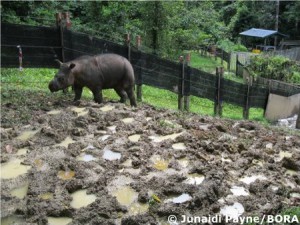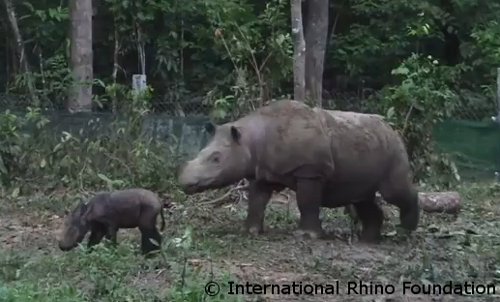Last weekend, there was some happy news for Way Kambas National Park in Sumatra: their captive female Sumatran rhino (Dicerorhinus sumatrensis) Ratu gave birth to a healthy male calf. Previously Ratu has had two miscarriages, and the 15 month pregnancy made it a nail-biting waiting game for the staff at the park. The calf, named Andatu, is the first Sumatran rhino ever to be born in captivity in Indonesia, and only the fourth captive birth in a century.
In 2007, Andalas, a male rhino from the USA was flown to Sumatra to be introduced to the sanctuary’s three females, in the hope that he would breed with at least one of them. Andalas himself was the first Sumatran rhino to be born in captivity in 112 years. On Friday, the International Rhino Foundation announced that Ratu’s placental cells would be collected with the intention of generating stem cells, which may help to cure diseases and promote reproduction in the species.
The rhinos are some of the world’s most endangered mammals. In addition to the Sumatran rhino, two others are Critically Endangered: the black (Diceros bicornis) and the Javan (Rhinoceros sondaicus), both of which are EDGE species. Last year there were two tragic extinctions: the Vietnamese rhino (Rhinoceros sondaicus annamiticus) and the western black rhino (Diceros bicornis longipes). The biggest threat to them is poaching: their horns are ground and used as treatment for various illnesses in traditional Chinese medicine, even though several scientific studies have proved that the horns have no medicinal value at all.
After decades of vast deforestation and poaching, it is estimated that there are only around 200 wild individuals in highly fragmented populations around Borneo and Sumatra, with doubts that the population living in the Malaysian peninsula still exists. The fact that they are so spread apart geographically presents a myriad of problems, the primary one being that males and females from different areas have a low chance of running into each other. On top of this, females can only have one calf every three years, and males are usually eight years old before they mature sexually.

At Way Kambas Park, the rhinos have large enclosures full of native vegetation to simulate their natural environment and encourage normal behaviours, but at the same time are closely monitored by guards and veterinarians. In Borneo, the wild population of Sumatran rhinos probably number less than 40. Tam (a male) and Puntung (a female – left) are in semi-captive pens in Tabin Wildlife Reserve, but conservationists are still waiting for the government to provide them with a proper sanctuary.
Read more about the work of the Bornean Rhino Alliance, or check out the video footage of Ratu and Andatu…
